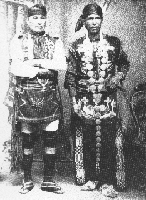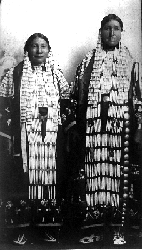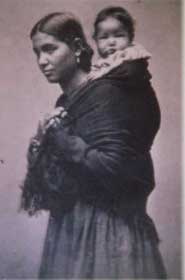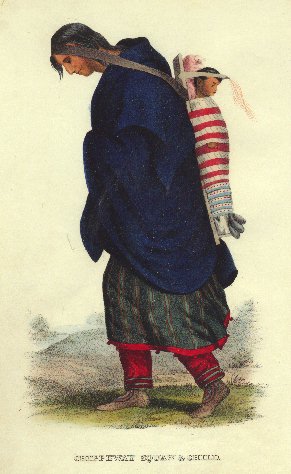 Myth 1
Myth 1
In the beginning before there were people, before there were animals a
lone woman lived in a cave. She lived on the roots and berries of the
plants. One night a magical dog crept into her cave and stretched out on
the her bed beside her. As the night grew long the dog began to change.
His body became smooth and almost hairless. His limbs grew long and
straight. His features changed into those of a handsome warrior. Nine
months later the woman birthed a child. He was the first Chippewa male
and through him came the Chippewa peoples.
Myth 2
When the Earth was young it had a family. The moon, or Grandmother and
the sun, called Grandfather. The Earth was a woman - Mother Earth -
because from her came all living things. Mother Earth was given four
directions - East, South, West, and North, each with physical and
spiritual powers.When Mother Earth was young Creator, or Gichi-Manidoo
as Ojibwe people call him, filled her with beauty. He sent singers in
the form of birds and swimmers in the water. He placed plants, trees,
insects, crawlers and four-legged animals on the land.Gichi-Manidoo then
blew into four parts of Mother Earth using the sacred megis shell. From
the union of these four and his breath, two-leggeds or man, was born.
Thus, man was the last form of life to be put on Earth. From this
original man came the Anishinaabe - or The Original People.
The Great Serpent and the Flood
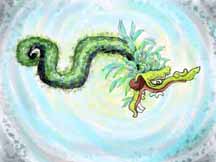
From Maine and Nova Scotia to the Rocky Mountains, Indians told stories
about the Great Serpent. More than a century ago the serpent was
considered to be "a genuine spirit of evil." Some version of the story
of the Great Flood of long ago, as recounted here, is told around the
world.
Nanabozho (Nuna-bozo, accented on bozo) was the hero of many
stories told by the Chippewa Indians. At one time they lived on the
shores of Lake Superior, in what are now the states of Minnesota and
Wisconsin and the province of Ontario.
One day when Nanabozho returned to his lodge after a long journey, he
missed his young cousin who lived with him. He called the cousin's name
but heard no answer. Looking around on the sand for tracks, Nanabozho
was startled by the trail of the Great Serpent. He then knew that his
cousin had been seized by his enemy.
Nanabozho picked up his bow and arrows and followed the track of the
serpent. He passed the great river, climbed mountains, and crossed over
valleys until he came to the shores of a deep and gloomy lake. It is now
called Manitou Lake, Spirit Lake, and also the Lake of Devils. The
trail of the Great Serpent led to the edge of the water.
Nanabozho could see, at the bottom of the lake, the house of the Great
Serpent. It was filled with evil spirits, who were his servants and his
companions. Their forms were monstrous and terrible. Most of them, like
their master, resembled spirits. In the centre of this horrible group
was the Great Serpent himself,
coiling his terrifying length around the cousin of Nanabozho.
The head of the Serpent was red as blood. His fierce eyes glowed like
fire. His entire body was armed with hard and glistening scales of every
color and shade. Looking down on these twisting spirits of evil,
Nanabozho made up his mind that he would get revenge on them for the
death of his cousin.
He said to the clouds, "Disappear!" And the clouds went out of sight.
"Winds, be still at once!" And the winds became still.
When the air over the lake of evil spirits had become stagnant,
Nanabozho said to the sun, "Shine over the lake with all the fierceness
you can. Make the water boil."
In these ways, thought Nanabozho, he would force the Great Serpent to
seek the cool shade of the trees growing on the shores of the lake.
There he would seize the enemy and get revenge.
After giving his orders, Nanabozho took his bow and arrows and placed
himself near the spot where he thought the serpents would come to enjoy
the shade. Then he changed himself into the broken stump of a withered
tree.
The winds became still, the air stagnant, and the sun shot hot rays from
a cloudless sky. In time, the water of the lake became troubled, and
bubbles rose to the surface. The rays of the sun had penetrated to the
home of the serpents. As the water bubbled and foamed, a serpent lifted
his head above the center of the lake and gazed around the shores. Soon
another serpent came to the surface. Both listened for the footsteps of
Nanabozho, but they heard him nowhere.
"Nanabozho is sleeping," they said to one another. And then they plunged
beneath the waters, which seemed to hiss as they closed over the evil
spirits.
Not long after, the lake became more troubled. Its water boiled from its
very depths, and the hot waves dashed wildly against the rocks on its
banks. Soon the Great Serpent came slowly to the surface of the water
and moved toward the shore. His blood-red crest glowed. The reflection
from his scales was blinding--as blinding as the glitter of a
sleet-covered forest beneath the winter sun. He was followed by all the
evil spirits. So great was their number that they soon covered the
shores of the lake.
When they saw the broken stump of the withered tree, they suspected that
it might be one of the disguises of Nanabozho. They knew his cunning.
One of the serpents approached the stump,
wound his tail around it, and tried to drag it down into the lake.
Nanabozho could hardly keep from crying aloud, for the tail of the
monster prickled his sides. But he stood firm and was silent.
The evil spirits moved on. The Great Serpent glided into the forest and
wound his many coils around the trees. His companions also found
shade--all but one. One remained near the shore to listen for the
footsteps of Nanabozho.
From the stump, Nanabozho watched until all the serpents were asleep and
the guard was intently looking in another direction. Then he silently
drew an arrow from his quiver, placed it in his bow, and aimed it at the
heart of the Great Serpent. It reached its mark. With a howl that shook
the mountains and startled the
wild beasts in their caves, the monster awoke. Followed by its terrified
companions, which also were howling with rage and terror, the Great
Serpent plunged into the water.
At the bottom of the lake there still lay the body of Nanabozho's
cousin. In their fury the serpents tore it into a thousand pieces. His
shredded lungs rose to the surface and covered the lake with whiteness.
The Great Serpent soon knew that he would die from his wound, but he and
his companions were determined to destroy Nanabozho. They caused the
water of the lake to swell upward and to pound against the shore with
the sound of many thunders. Madly the flood rolled over the land, over
the tracks of Nanabozho, carrying with it rocks and trees. High on the
crest of the highest wave floated the wounded Great Serpent. His eyes
glared around him, and his hot breath mingled with the hot breath of his
many companions.
Nanabozho, fleeing before the angry waters, thought of his Indian
children. He ran through their villages, shouting, "Run to the
mountaintops! The Great Serpent is angry and is flooding the earth! Run!
Run!"
The Indians caught up their children and found safety on the mountains.
Nanabozho continued his flight along the base of the western hills and
then up a high mountain beyond Lake Superior, far to the north. There he
found many men and animals that had escaped from the flood that was
already covering the valleys and plains and even the highest hills.
Still the waters continued to rise. Soon all the mountains were under
the flood, except the high one on which stood Nanabozho.
There he gathered together timber and made a raft. Upon it the men and
women and animals with him placed themselves. Almost immediately the
mountaintop disappeared from their view, and they floated along on the
face of the waters. For many days they floated. At long last, the flood
began to subside. Soon the people on the raft saw the trees on the tops
of the mountains. Then they saw the mountains and hills, then the plains
and the
valleys.
When the water disappeared from the land, the people who survived
learned that the Great Serpent was dead and that his companions had
returned to the bottom of the lake of spirits. There they remain to this
day. For fear of Nanabozho, they have never dared to come forth again.
